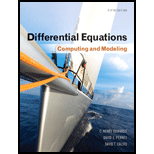
Given that
Want to see the full answer?
Check out a sample textbook solution
Chapter 7 Solutions
Differential Equations: Computing and Modeling (5th Edition), Edwards, Penney & Calvis
Additional Engineering Textbook Solutions
SURVEY OF OPERATING SYSTEMS
Introduction To Programming Using Visual Basic (11th Edition)
Web Development and Design Foundations with HTML5 (8th Edition)
Degarmo's Materials And Processes In Manufacturing
Starting Out with C++ from Control Structures to Objects (9th Edition)
Starting Out with Programming Logic and Design (5th Edition) (What's New in Computer Science)
- I need to know about the use and configuration of files and folders, and their attributes in Windows Server 2019.arrow_forwardSouthern Airline has 15 daily flights from Miami to New York. Each flight requires two pilots. Flights that do not have two pilots are canceled (passengers are transferred to other airlines). The average profit per flight is $6000. Because pilots get sick from time to time, the airline is considering a policy of keeping four *reserve pilots on standby to replace sick pilots. Such pilots would introduce an additional cost of $1800 per reserve pilot (whether they fly or not). The pilots on each flight are distinct and the likelihood of any pilot getting sick is independent of the likelihood of any other pilot getting sick. Southern believes that the probability of any given pilot getting sick is 0.15. A) Run a simulation of this situation with at least 1000 iterations and report the following for the present policy (no reserve pilots) and the proposed policy (four reserve pilots): The average daily utilization of the aircraft (percentage of total flights that fly) The…arrow_forwardWhy is JAVA OOP is really difficult to study?arrow_forward
- My daughter is a Girl Scout and it is time for our cookie sales. There are 15 neighbors nearby and she plans to visit every neighbor this evening. There is a 40% likelihood that someone will be home. If someone is home, there is an 85% likelihood that person will make a purchase. If a purchase is made, the revenue generated from the sale follows the Normal distribution with mean $18 and standard deviation $5. Using @RISK, simulate our door-to-door sales using at least 1000 iterations and report the expected revenue, the maximum revenue, and the average number of purchasers. What is the probability that the revenue will be greater than $120?arrow_forwardQ4 For the network of Fig. 1.41: a- Determine re b- Find Aymid =VolVi =Vo/Vi c- Calculate Zi. d- Find Ay smid e-Determine fL, JLC, and fLE f-Determine the low cutoff frequency. g- Sketch the asymptotes of the Bode plot defined by the cutoff frequencies of part (e). h-Sketch the low-frequency response for the amplifier using the results of part (f). Ans: 28.48 2, -72.91, 2.455 KS2, -54.68, 103.4 Hz. 38.05 Hz. 235.79 Hz. 235.79 Hz. 14V 15.6ΚΩ 68kQ 0.47µF Vo 0.82 ΚΩ V₁ B-120 3.3kQ 0.47µF 10kQ 1.2k0 =20µF Z₁ Fig. 1.41 Circuit forarrow_forwarda. [10 pts] Write a Boolean equation in sum-of-products canonical form for the truth table shown below: A B C Y 0 0 0 1 0 0 1 0 0 1 0 0 0 1 1 0 1 0 0 1 1 0 1 0 1 1 1 1 0 1 1 0 a. [10 pts] Minimize the Boolean equation you obtained in (a). b. [10 pts] Implement, using Logisim, the simplified logic circuit. Include an image of the circuit in your report.arrow_forward
- Using XML, design a simple user interface for a fictional app. Your UI should include at least three different UI components (e.g., TextView, Button, EditText). Explain the purpose of each component in your design-you need to add screenshots of your work with your name as part of the code to appear on the interface-. Screenshot is needed.arrow_forwardQ4) A thin ring of radius 5 cm is placed on plane z = 1 cm so that its center is at (0,0,1 cm). If the ring carries 50 mA along a^, find H at (0,0,a).arrow_forward4. [15 pts] A logic function F of four variables a; b; c; d is described by the following K-map. Derive the fully minimized SOP logic expression form of F. cd ab 00 01 11 10 00 0 0 0 1 01 1 0 0 1 11 1 0 1 1 10 0 0 1 1arrow_forward
- 2. [20 pts] Student A B will enjoy his picnic on sunny days that have no ants. He will also enjoy his picnic any day he sees a hummingbird, as well as on days where there are ants and ladybugs. a. Write a Boolean equation for his enjoyment (E) in terms of sun (S), ants (A), hummingbirds (H), and ladybugs (L). b. Implement in Logisim, the logic circuit of E function. Use the Circuit Analysis tool in Logisim to view the expression, include an image of the expression generated by Logisimarrow_forwardHow would I go about creating this computer database in MariaDB with sql? Create a database name "dbXXXXXX" Select the database using the "use [database name]" command. Now you are in the database. Based on the above schema from Enrolment System database, create all the tables with the last 6 digits of "123456", then the table name for table Lecturer should be "123456_Lecturer". Refer to basic SQL lecture note to create table that has primary keys and Foreign Keys. Provide the datatype of each attributes. Add a column called "Department" with datatype "VARCHAR(12)" to the table "Lecturer". Shows the metadata of the updated "Lecturer" table. (Use Describe command) Drop the "Department" column from the table "Lecturer", and show the metadata of the updated "Lecturer" table. Insert three (3) data to each of the table in the tables created. Note: If you have foreign key issues, please disable foreign key constraints before inserting the data, see below SET FOREIGN_KEY_CHECKS=0;…arrow_forwardCSE330 Discrete Mathematics 1. In the classes, we discussed three forms of floating number representations as given below, (1) Standard/General Form, (2) Normalized Form, (3) Denormalized Form. 3. Consider the real number x = (3.395) 10 (a) (b) Convert the decimal number x into binary format up to 7 binary places (7 binary digits after decimal) Convert the calculated value into denormalized form and calculate fl(x) for m=4 Don't use any Al tool show answer in pen a nd paper then take pi ctures and sendarrow_forward
 C++ for Engineers and ScientistsComputer ScienceISBN:9781133187844Author:Bronson, Gary J.Publisher:Course Technology Ptr
C++ for Engineers and ScientistsComputer ScienceISBN:9781133187844Author:Bronson, Gary J.Publisher:Course Technology Ptr Operations Research : Applications and AlgorithmsComputer ScienceISBN:9780534380588Author:Wayne L. WinstonPublisher:Brooks Cole
Operations Research : Applications and AlgorithmsComputer ScienceISBN:9780534380588Author:Wayne L. WinstonPublisher:Brooks Cole C++ Programming: From Problem Analysis to Program...Computer ScienceISBN:9781337102087Author:D. S. MalikPublisher:Cengage Learning
C++ Programming: From Problem Analysis to Program...Computer ScienceISBN:9781337102087Author:D. S. MalikPublisher:Cengage Learning- COMPREHENSIVE MICROSOFT OFFICE 365 EXCEComputer ScienceISBN:9780357392676Author:FREUND, StevenPublisher:CENGAGE L
 LINUX+ AND LPIC-1 GDE.TO LINUX CERTIF.Computer ScienceISBN:9781337569798Author:ECKERTPublisher:CENGAGE L
LINUX+ AND LPIC-1 GDE.TO LINUX CERTIF.Computer ScienceISBN:9781337569798Author:ECKERTPublisher:CENGAGE L Systems ArchitectureComputer ScienceISBN:9781305080195Author:Stephen D. BurdPublisher:Cengage Learning
Systems ArchitectureComputer ScienceISBN:9781305080195Author:Stephen D. BurdPublisher:Cengage Learning





